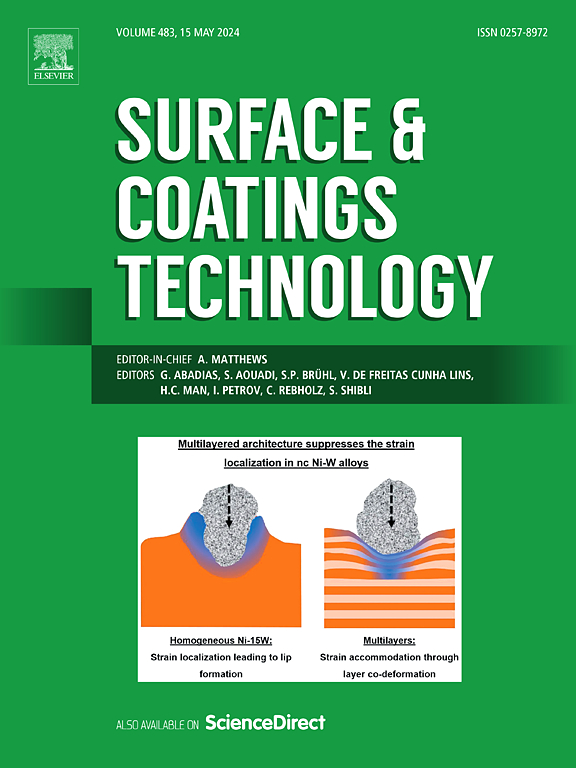Micro-arc oxidation treatment applied on the surface of β TiNb matrix composites as a strategy to modulate cellular behavior
IF 5.3
2区 材料科学
Q1 MATERIALS SCIENCE, COATINGS & FILMS
引用次数: 0
Abstract
Large bone injuries require long-term implant materials with multifunctional properties. While β-type Ti![]() Nb alloys offer a reduced elastic modulus closer to bone stiffness, metallic materials remain susceptible to degradation under friction in corrosive environments, such as articulating joints exposed to body fluids. In this context, Ti-based matrix composites (TMCs) have emerged as promising alternatives, as β Ti
Nb alloys offer a reduced elastic modulus closer to bone stiffness, metallic materials remain susceptible to degradation under friction in corrosive environments, such as articulating joints exposed to body fluids. In this context, Ti-based matrix composites (TMCs) have emerged as promising alternatives, as β Ti![]() Nb matrices reinforced with TiC and/or TiB precipitates have recently demonstrated superior tribocorrosion resistance compared to unreinforced β Ti
Nb matrices reinforced with TiC and/or TiB precipitates have recently demonstrated superior tribocorrosion resistance compared to unreinforced β Ti![]() Nb alloys, while maintaining low elastic moduli. The current study focuses on enhancing the biological properties of β-TMCs through surface micro-arc oxidation (MAO) treatment. An electrolyte enriched with Ca-, P-, and Mg-based compounds was used to generate bioactive porous oxide coatings. X-ray photoelectron spectroscopy (XPS) revealed Ca/P ratios close to 1.67 in all MAO coatings, while high-resolution spectra identified phosphate functional groups and calcium carbonate, indicating favorable compositions for bone regeneration. TiB and TiC may have formed volatile oxides such as B2O3 and CO2, whereas only B2O3 was detected in the XPS results. Furthermore, TiB in the substrate refined pore sizes to below 1 μm2 and increased MAO coating thickness to over 11 μm, although neither TiB nor TiC affected the anatase-to-rutile ratio. In vitro cellular assays demonstrated that MAO-treated β-TMCs facilitate osteoblast proliferation due to their controlled porous surface structure and biomimetic composition. These findings support β-TMCs as promising candidates for biomedical applications, with MAO treatment serving as an effective strategy for enhancing biological performance. Further preclinical studies are required to validate their clinical potential.
Nb alloys, while maintaining low elastic moduli. The current study focuses on enhancing the biological properties of β-TMCs through surface micro-arc oxidation (MAO) treatment. An electrolyte enriched with Ca-, P-, and Mg-based compounds was used to generate bioactive porous oxide coatings. X-ray photoelectron spectroscopy (XPS) revealed Ca/P ratios close to 1.67 in all MAO coatings, while high-resolution spectra identified phosphate functional groups and calcium carbonate, indicating favorable compositions for bone regeneration. TiB and TiC may have formed volatile oxides such as B2O3 and CO2, whereas only B2O3 was detected in the XPS results. Furthermore, TiB in the substrate refined pore sizes to below 1 μm2 and increased MAO coating thickness to over 11 μm, although neither TiB nor TiC affected the anatase-to-rutile ratio. In vitro cellular assays demonstrated that MAO-treated β-TMCs facilitate osteoblast proliferation due to their controlled porous surface structure and biomimetic composition. These findings support β-TMCs as promising candidates for biomedical applications, with MAO treatment serving as an effective strategy for enhancing biological performance. Further preclinical studies are required to validate their clinical potential.

求助全文
约1分钟内获得全文
求助全文
来源期刊

Surface & Coatings Technology
工程技术-材料科学:膜
CiteScore
10.00
自引率
11.10%
发文量
921
审稿时长
19 days
期刊介绍:
Surface and Coatings Technology is an international archival journal publishing scientific papers on significant developments in surface and interface engineering to modify and improve the surface properties of materials for protection in demanding contact conditions or aggressive environments, or for enhanced functional performance. Contributions range from original scientific articles concerned with fundamental and applied aspects of research or direct applications of metallic, inorganic, organic and composite coatings, to invited reviews of current technology in specific areas. Papers submitted to this journal are expected to be in line with the following aspects in processes, and properties/performance:
A. Processes: Physical and chemical vapour deposition techniques, thermal and plasma spraying, surface modification by directed energy techniques such as ion, electron and laser beams, thermo-chemical treatment, wet chemical and electrochemical processes such as plating, sol-gel coating, anodization, plasma electrolytic oxidation, etc., but excluding painting.
B. Properties/performance: friction performance, wear resistance (e.g., abrasion, erosion, fretting, etc), corrosion and oxidation resistance, thermal protection, diffusion resistance, hydrophilicity/hydrophobicity, and properties relevant to smart materials behaviour and enhanced multifunctional performance for environmental, energy and medical applications, but excluding device aspects.
 求助内容:
求助内容: 应助结果提醒方式:
应助结果提醒方式:


